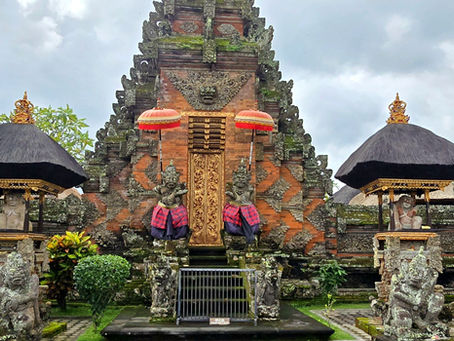top of page

GLOBAL SHANANIGANS

Search


Pura Dalem Ubud - The Temple of Death
In the shadowed heart of Ubud stands Pura Dalem, a temple steeped in ancient power and shadowed secrets. One of the area’s most formidable sacred sites, it pulses at the centre of the local spiritual life, a place where worship, dark rituals and otherworldly performances unfold. Its moss clad stone carvings depict guardian spirits and fearsome deities, whispering of life, death and the unseen forces that linger at the edge of perception.
Shannon


Yeh Pulu - Water of the Stone Jar
Hidden in a lonely ravine between the Petanu and Pakrisan Rivers, the ruins of this unique 14th-century rock relief lay buried for centuries under volcanic eruptions and vegetation. The site was excavated by Dutch authorities in 1925 and in 1949, a stone gutter was cemented on top in order to drain off water, to prevent erosion and vegetation from taking hold, revealing even more of the stone mural.
Shannon


Ulu Petanu Waterfall
Tucked deep within Tegallalang village, Ulu Petanu Waterfall offers a peaceful, intimate retreat far from Bali’s busy tourist spots, where crystal-clear waters cascade gently amid dense jungle. Steeped in legend, it is also known as the sacred site linked to King Mayadenawa, whose blood is said to have cursed the nearby river, making the waterfall a place of spiritual cleansing and reverence.
Shannon


Batuan Temple
In the heart of Batuan village stands Pura Puseh Desa Batuan, one of Bali’s oldest and most spiritually charged temples. Founded in 1020 AD and recorded in Balinese historical texts for over a millennium, it is rooted in something far older, believed to have been built atop a megalithic stone circle, echoing the ancient power of Stonehenge, where ancestral rites were once performed.
Shannon


Pura Ulun Danu Batur - The Temple of Ash and Mercy
First established in the 17th century, Pura Batur is one of Bali’s most venerated temples, second only to Pura Besakih on the sacred slopes of Mount Agung. Perched at roughly 900 metres above sea level, this mountain sanctuary overlooks the dramatic caldera of Mount Batur, an active volcano steeped in myth and raw geological power.
Shannon


Besakih Temple
The origins of Pura Besakih are veiled in ancient legend, its story whispered through centuries beyond recorded memory. For more than a thousand years, this sprawling temple complex has stood as the spiritual heart and the “Mother Temple” of the whole island. Perched nearly a kilometre above the sea, on the jagged southwestern flank of Mount Agung, it commands a breathtaking view and an air of sacred power.
Shannon


Goa Garba and the Legacy of Kebo Iwa
Carved into a rugged cliff above the sacred Pakerisan River, this ancient hermitage and unique archaeological site offers a rare glimpse into Bali’s pre Hindu past. Hidden from view, it shelters mysterious megaliths, silent echoes of a time long before Hindu-Buddhist influence shaped the island.
Shannon


Gunung Lebah - The Birthplace of Ubud
Rising from the heart of Ubud, Gunung Lebah Temple was founded in the 8th century by the Indian priest Rsi Markandeya as a sanctuary for meditation and spiritual retreat. Nestled at the confluence of the Wos and Pakerisan rivers, where their waters merge to form the sacred Campuhan, the site hums with serene energy, surrounded by forests rich with medicinal plants believed to heal both body and soul.
Shannon


Ayutthaya - The Fallen City of Siam
Once the jewel of Siam, Ayutthaya now lies in silence, its streets soaked in blood and its temples crumbling under the weight of history. Execution grounds, ruined chedis, and desecrated monasteries bear witness to the brutal fall at the hands of the Burmese army, where kings, monks, and nobles met violent ends. The shadows of the city are said to whisper with the voices of the betrayed and the slain, a restless reminder that even in ruin, Ayutthaya’s dark legacy refuses to f
Shannon


Thành Chương's Viet Palace
Tucked away on Sóc Sơn Mountain, roughly 30km's north of Hanoi, Thành Chương’s Viet Palace is far more than a museum or art gallery, it is a cultural time capsule and a living work of art, meticulously crafted by the celebrated contemporary Vietnamese painter Thành Chương.
Shannon


Jatiluwih Rice Terraces
The village of Jatiluwih offers a living testament to the ancient harmony between humans, nature and the divine. Overlooked by the brooding silhouette of Mount Batukaru, Bali’s second-highest volcano and a sacred site in its own right, Jatiluwih’s name translates to "truly beautiful," a title it lives up to with dramatic sweeps of emerald-green rice terraces that ripple across the landscape.
Shannon


The Holy Springs of Tirta Empul
Founded in 962AD during the Warmadewa dynasty, Tirta Empul is one of Bali’s most sacred temples, located in the cool highlands of Tampaksiring near Manukaya village. Its name, which means "holy water spring," is derived from a natural spring that bubbles up into the temple’s central pool and continues to feed the nearby Pakerisan River. This revered site is dedicated to Vishnu, the Hindu God of Water and Preservation
Shannon


Ayung River Rafting - Bali's Scenic Waterway
The Ayung River is Bali’s longest waterway, stretching 68.5 km's from the lush northern highlands down to the southern coast at Sanur. It snakes its way through deep gorges, remote jungles, rice terraces and traditional villages, making it one of the island’s most scenic natural features. Despite its size, the Ayung maintains a gentle flow for much of its length, making it ideal for outdoor activities like rafting and river trekking.
Shannon


Garuda - The Immortal Hunter
Garuda, the colossal bird being of Hindu myth, soars through Balinese religious imagination not as a gentle guardian but as a relentless force cutting across the realms of gods, demons and mortals. His wings are said to darken the sky when spread, the violent wind from their beat capable of stripping the leaves from the forests.
Shannon


The Blanco Renaissance Museum
Perched on a ridge above Ubud’s sacred Campuhan River lies one of Bali’s most curious artistic enclaves, the Blanco Renaissance Museum, once the home and studio of the flamboyant artist Don Antonio Blanco. Often called the “Dali of Bali,” Blanco's vibrant persona and sensual art helped solidify his reputation as one of the island's most celebrated foreign creatives.
Shannon


Nusa Lembongan - Bali’s Sister Island
Just 12 kilometres off the southeast coast of Bali lies Nusa Lembongan, a compact gem in a trio of islands that make up part of the Lesser Sunda chain, born from volcanic origins. Though it spans only 8 square km's, the island is a place of striking contrasts and natural beauty. Bright coral reefs encircle the island, while soft white beaches and weathered limestone cliffs shape its edges.
Shannon


Wat Chiang Man - Chiang Mai's Oldest Temple
Dating back to 1297, Chiang Mai’s oldest standing temple, Wat Chiang Man, was originally founded by King Mengrai as a royal encampment during the construction of his new capital. As the first temple within the city walls, it soon became a central hub for the emerging Lanna Kingdom, hosting religious ceremonies, political gatherings and significant social events, intertwining both spiritual devotion and civic life at the heart of the city.
Shannon


Dewi Danu and Dewi Sri – The Sacred Sisters of Bali
Dewi Danu rules the highland lakes while Dewi Sri dwells in the fertile lowlands, yet their powers meet within Bali’s sacred subak system. Waters from the mountains descend through canals to the rice fields, where temples serve as ritual gateways, transforming the flow of water and the growth of grain into a divine exchange between earth and goddess.
Shannon


Cat Cat Village
Cat Cát Village lies in the misty mountains of northern Vietnam, known for its cascading waterfalls, terraced hillsides and narrow stone paths that wind through the valley. The landscape, shaped by water and cloud, gives the village a magical atmosphere that draws travellers seeking both beauty and stillness.
Shannon


Furong Ancient Waterfall Town - The Widow's Veil
Originally known as Wangcun, this stunning 2000 year old village began as a sleepy Tujia ethnic settlement, nestled deep within the rugged cliffs of western Hunan Province. Established during the Han Dynasty, it was once little more than a modest cluster of wooden dwellings, with smoke curling gently from hearth fires and echoes of ancestral chants reverberating across the canyon.
Shannon
bottom of page